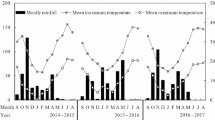Abstract
The widespread planting of Sesbania sesban fallows for replenishing soil fertility in eastern Zambia has the potential of causing pest outbreaks in the future. The pure S. sesban fallows may not produce enough biomass needed for replenishing soil fertility in degraded soils. Therefore, an experiment was conducted at Kagoro in Katete district in the Eastern Province of Zambia from 1997 to 2002 to test whether multi-species fallows, combining non-coppicing with coppicing tree species, are better than mono-species fallows of either species for soil improvement and increasing subsequent maize yields. Mono-species fallows of S. sesban (non-coppicing), Gliricidia sepium, Leucaena leucocephala and Acacia angustissima (all three coppicing), and mixed fallows of G. sepium + S. sesban, L. leucocephala + S. sesban, A. angustissima + S. sesban and natural fallow were compared over a three-year period. Two maize (Zea mays) crops were grown subsequent to the fallows. The results established that S. sesban is poorly adapted and G. sepiumis superior to other species for degraded soils. At the end of three years, sole G. sepium fallow produced the greatest total biomass of 22.1 Mg ha−1 and added 27 kg ha−1 more N to soil than G. sepium + S. sesban mixture. During the first post-fallow year, the mixed fallow at 3.8 Mg ha−1 produced 77% more coppice biomass than sole G. sepium, whereas in the second year both sole G. sepium and the mixture produced similar amounts of biomass (1.6 to 1.8 Mg ha−1). The G. sepium + S. sesban mixture increased water infiltration rate more than sole G. sepium, but both these systems had similar effects in reducing soil resistance to penetration compared with continuous maize without fertilizer. Although sole G. sepium produced high biomass, it was G. sepium + S. sesban mixed fallow which resulted in 33% greater maize yield in the first post-fallow maize. However, both these G. sepium-based fallows had similar effects on the second post-fallow maize. Thus the results are not conclusive on the beneficial effects of G. sepium + S. sesban mixture over sole G. sepium.
Similar content being viewed by others
References
Anderson J.M. and Ingram J.S.I. 1993. Tropical Soil Biology and Fertility: A Handbook of Methods. 2nd edition. CAB Interna-tional, Wallingford, UK, 221 pp.
Bouwer H. 1986. Intake rate: Cylinder infiltrometer. In: Klute A. (ed.), Methods of Soil Analysis: Part 1, Physical and Miner-alogical Methods. Agronomy Monograph Number 9, American Society of Agronomy, Madison, Wisconsin, USA, pp. 825–844.
Dorich R.A. and Nelson D.W. 1984. Evaluation of manual cadmium reduction methods for determination of nitrate in potassium chloride extracts of soil. Soil Science Society of America Journal 48: 72–75.
Gathumbi S.M. 2000. Nitrogen sourcing by fast-growing legumes in pure and mixed species fallows in western Kenya. PhD thesis, Wye College, University of London, Wye, Kent, UK.
Ikerra S., Maghembe J., Smithson P. and Buresh R. 1999. Soil nitrogen dynamics and relationships with maize yields in gliricidia- maize intercrop in Malawi. Plant and Soil 211: 155–164.
Kostiakov A.N. 1932. On the dynamics of the coefficient of water-percolation in soils and on the necessity for studying it from a dynamic point of view for purposes of amelioration. Transactions of the Sixth International Society of Soil Science, Russian Part A: 17–21.
Kwesiga F. and Coe R. 1994. The effect of short rotation Sesbania sesban planted fallows on maize yield. Forest Ecology and Management 64: 199–208.
Kwesiga F and Kamau IN (eds) 1989. Agroforestry Potential in the Unimodal Upland Plateau of Zambia. Agroforestry Research Network for Africa (AFRENA) Report No 7, ICRAF, Nairobi, 115 pp.
Lal R. 1985. Mechanized tillage systems effects on physical properties of an Alfisol in watersheds cropped to maize. Soil Tillage Research 6: 149–161.
Lal R., Wilson G.F. and Okigbo B.N. 1978. No-tillage farming after various grasses and leguminous cover crops in tropical Alfisols I. Crop performance. Field Crops Research 1: 71–84.
Lal R. 1989. Agroforestry systems and soil surface management of a tropical Alfisol: IV. Effects on soil physical and mechanical properties. Agroforestry Systems 8: 197–215.
Maroko J.B., Buresh R.J. and Smithson P.C. 1998. Soil nitrogen availability as affected by fallow-maize systems on two soils in Kenya. Biology and Fertility of Soils 26: 229–234.
Pereira H.C., Wood R.A., Brozostowski H.W. and Hosegood P.A. 1958. Water conservation by fallowing in semi-arid tropical East Africa. Imperial Journal of Experimental Agriculture 26: 203–228.
Torquebiau E.F. and Kwesiga F. 1996. Root development in Sesbania sesban fallow-maize system in eastern Zambia. Agro-forestry Systems 34: 193–211.
Van Noordwijk M. 1989. Rooting depth in cropping systems in the humid tropics in relation to nutrient use efficiency. In: Van der Heide J. (ed.), Nutrient Management for Food Crop Production in Tropical Farming Systems. Institute for Soil Fertility, Haren, The Netherlands, pp. 129–144.
Wilkinson G.E. 1975. Effects of grass fallow rotations in Northern Nigeria. Tropical Agriculture (Trinidad) 52: 97–103.
Willey R.W. 1990. Resource use in intercropping systems. Agricultural Water Management 17: 215–231.
Author information
Authors and Affiliations
Corresponding author
Rights and permissions
About this article
Cite this article
Chirwa, T., Mafongoya, P. & Chintu, R. Mixed planted-fallows using coppicing and non-coppicing tree species for degraded Acrisols in eastern Zambia. Agroforestry Systems 59, 243–251 (2003). https://doi.org/10.1023/B:AGFO.0000005225.12629.61
Issue Date:
DOI: https://doi.org/10.1023/B:AGFO.0000005225.12629.61




